Treatment is dependent on accurate determination of the nature and severity of the injury.
Conservative treatment is considered for nondisplaced fractures, anatomically reduced fractures (although functional outcome may be better if treated operatively), and patients with serious comorbidities who are not surgical candidates.[43]Mordecai S, Al-Hadithy N. Management of ankle fractures. BMJ. 2011 Oct 28;343:d5204.
Nonoperative management includes casting, either weight-bearing or nonweight-bearing, for a minimum of 6 weeks.[19]Kyriacou H, Mostafa AMHAM, Davies BM, et al. Principles and guidelines in the management of ankle fractures in adults. J Perioper Pract. 2021 Nov;31(11):427-34.
https://journals.sagepub.com/doi/full/10.1177/1750458920969029
http://www.ncbi.nlm.nih.gov/pubmed/33826430?tool=bestpractice.com
[43]Mordecai S, Al-Hadithy N. Management of ankle fractures. BMJ. 2011 Oct 28;343:d5204. Functional management with controlled range of motion and combinations of nonweight-bearing or weight-bearing may also be considered.[44]Petrisor BA, Poolman R, Koval K, et al. Management of displaced ankle fractures. J Orthop Trauma. 2006;20:515-518.
http://www.ncbi.nlm.nih.gov/pubmed/16891946?tool=bestpractice.com
UK guidelines recommend close contact casts as an alternative to surgery for patients over the age of 60 years, if reduction can be maintained with casts.[7]British Orthopaedic Association Standards for Trauma. The management of ankle fractures. Aug 2016 [internet publication].
https://www.boa.ac.uk/static/f8b1c499-c38a-4805-8cb8d8eb3087bca7/8be763eb-5921-4cb2-b6802f3e65ce8e7f/the%20management%20of%20ankle%20fractures.pdf
[45]Willett K, Keene DJ, Mistry D, et al. Close contact casting vs surgery for initial treatment of unstable ankle fractures in older adults: a randomized clinical trial. JAMA. 2016 Oct 11;316(14):1455-63.
http://www.ncbi.nlm.nih.gov/pubmed/27727383?tool=bestpractice.com
One randomized controlled trial of 620 adults over the age of 60 years with acute, overtly unstable ankle fracture found the use of close contact casting compared with surgery resulted in similar functional outcomes at 6 months, with fewer wound complications.[45]Willett K, Keene DJ, Mistry D, et al. Close contact casting vs surgery for initial treatment of unstable ankle fractures in older adults: a randomized clinical trial. JAMA. 2016 Oct 11;316(14):1455-63.
http://www.ncbi.nlm.nih.gov/pubmed/27727383?tool=bestpractice.com
For conservatively treated fractures, it is important to gain serial radiographs to ensure the fracture has not been displaced again, joint congruity is maintained, and that it is healing appropriately. Repeat radiographs must be done immediately after reduction.[7]British Orthopaedic Association Standards for Trauma. The management of ankle fractures. Aug 2016 [internet publication].
https://www.boa.ac.uk/static/f8b1c499-c38a-4805-8cb8d8eb3087bca7/8be763eb-5921-4cb2-b6802f3e65ce8e7f/the%20management%20of%20ankle%20fractures.pdf
[43]Mordecai S, Al-Hadithy N. Management of ankle fractures. BMJ. 2011 Oct 28;343:d5204. Some experts also suggest repeating radiographs at 5-7 days postreduction.[43]Mordecai S, Al-Hadithy N. Management of ankle fractures. BMJ. 2011 Oct 28;343:d5204. In fracture patterns where stability is uncertain, patients should be reviewed within 2 weeks with further radiographs (weight-bearing if possible) to confirm the position remains acceptable.[7]British Orthopaedic Association Standards for Trauma. The management of ankle fractures. Aug 2016 [internet publication].
https://www.boa.ac.uk/static/f8b1c499-c38a-4805-8cb8d8eb3087bca7/8be763eb-5921-4cb2-b6802f3e65ce8e7f/the%20management%20of%20ankle%20fractures.pdf
Operative treatment should be considered if the fracture displaces or fails to heal.[43]Mordecai S, Al-Hadithy N. Management of ankle fractures. BMJ. 2011 Oct 28;343:d5204.
A simple stability-based fracture classification can be useful in choosing between nonoperative and operative treatment because approximately one half of these fractures can be treated nonoperatively with success.[46]Pakarinen H. Stability-based classification for ankle fracture management and the syndesmosis injury in ankle fractures due to a supination external rotation mechanism of injury. Acta Orthop Suppl. 2012;83:1-26.
http://www.ncbi.nlm.nih.gov/pubmed/23205893?tool=bestpractice.com
For displaced or unstable fractures there is a 0.68-fold reduction in risk of an adverse event favoring operative compared with nonoperative management.[44]Petrisor BA, Poolman R, Koval K, et al. Management of displaced ankle fractures. J Orthop Trauma. 2006;20:515-518.
http://www.ncbi.nlm.nih.gov/pubmed/16891946?tool=bestpractice.com
Operative fixation techniques for ankle fractures are varied. There are no guidelines for fixation devices. Surgery on the soft tissue should be performed as soon as reasonably possible. A delay in operative treatment is associated with an increased rate of complications such as infection and lowered patient satisfaction.[47]Schepers T, de Vries MR, van Lieshout EM, et al. The timing of ankle fracture surgery and the effect on infectious complications; a case series and systematic review of the literature. Int Orthop. 2013;37:489-94.
http://www.ncbi.nlm.nih.gov/pmc/articles/PMC3580081
http://www.ncbi.nlm.nih.gov/pubmed/23288046?tool=bestpractice.com
UK guidelines state that following surgery patients should be allowed to bear weight as tolerated in a splint or cast unless there are specific concerns regarding the stability of the fixation or contraindications, such as peripheral neuropathy or particular concerns about the status of the soft tissue in patients. All patients should be followed up in fracture clinic within 6 weeks of surgery to detect complications and confirm maintenance of reduction on radiographs.[7]British Orthopaedic Association Standards for Trauma. The management of ankle fractures. Aug 2016 [internet publication].
https://www.boa.ac.uk/static/f8b1c499-c38a-4805-8cb8d8eb3087bca7/8be763eb-5921-4cb2-b6802f3e65ce8e7f/the%20management%20of%20ankle%20fractures.pdf
Analgesics
Pain should be assessed regularly using a pain assessment scale suitable for the person's age, developmental stage, and cognitive function.[42]National Institute for Health and Care Excellence. Fractures (non-complex): assessment and management. Feb 2016 [internet publication].
https://www.nice.org.uk/guidance/ng38
In both the acute and aftercare settings, analgesics, including anti-inflammatory drugs, can be prescribed as necessary. There is no solid clinical evidence that nonsteroidal anti-inflammatory drugs (NSAIDs) inhibit fracture healing. NSAIDs are effective for pain management in musculoskeletal trauma. Until there is clear evidence, their use should not be discouraged.[48]Kurmis AP, Kurmis TP, O'Brien JX, et al. The effect of nonsteroidal anti-inflammatory drug administration on acute phase fracture-healing: a review. J Bone Joint Surg Am. 2012;94:815-823.
http://www.ncbi.nlm.nih.gov/pubmed/22552671?tool=bestpractice.com
However, NSAIDs should not be offered to frail or older adults with fractures.[42]National Institute for Health and Care Excellence. Fractures (non-complex): assessment and management. Feb 2016 [internet publication].
https://www.nice.org.uk/guidance/ng38
Emergency treatment
Open fractures require emergency treatment, with a saline irrigation and debridement of the open wound and removal of all devitalized tissue, as well as foreign debris, by experienced surgeons.[49]British Orthopaedic Association and British Association of Plastic, Reconstructive and Aesthetic Surgeons. Open fractures. Dec 2017 [internet publication].
https://www.boa.ac.uk/standards-guidance/boasts.html
The American Academy of Orthopaedic Surgeons (AAOS) recommends that patients with open fractures are brought to the operating room for debridement and irrigation as soon as possible, and ideally, within 24 hours postinjury.[39]American Academy of Orthopedic Surgeons. Prevention of surgical site infections after major extremity trauma: evidence-based clinical practice guideline. Mar 2022 [internet publication].
https://www.aaos.org/globalassets/quality-and-practice-resources/dod/ssitrauma/ssitraumacpg.pdf
[40]American Academy of Orthopaedic Surgeons. Appropriate Use Criteria: prevention of surgical site infection after high energy extremity trauma. Mar 2022 [internet publication].
https://www.orthoguidelines.org/go/auc/auc.cfm?auc_id=225052
Treatment of the fracture is then with internal fixation when the wound is determined to be clean.[39]American Academy of Orthopedic Surgeons. Prevention of surgical site infections after major extremity trauma: evidence-based clinical practice guideline. Mar 2022 [internet publication].
https://www.aaos.org/globalassets/quality-and-practice-resources/dod/ssitrauma/ssitraumacpg.pdf
[40]American Academy of Orthopaedic Surgeons. Appropriate Use Criteria: prevention of surgical site infection after high energy extremity trauma. Mar 2022 [internet publication].
https://www.orthoguidelines.org/go/auc/auc.cfm?auc_id=225052
In severely contaminated and comminuted fracture dislocations, temporizing external fixation may be required to facilitate repeated debridements, with delayed internal fixation.[39]American Academy of Orthopedic Surgeons. Prevention of surgical site infections after major extremity trauma: evidence-based clinical practice guideline. Mar 2022 [internet publication].
https://www.aaos.org/globalassets/quality-and-practice-resources/dod/ssitrauma/ssitraumacpg.pdf
[40]American Academy of Orthopaedic Surgeons. Appropriate Use Criteria: prevention of surgical site infection after high energy extremity trauma. Mar 2022 [internet publication].
https://www.orthoguidelines.org/go/auc/auc.cfm?auc_id=225052
Emergency fracture management includes splinting of the affected limb.[19]Kyriacou H, Mostafa AMHAM, Davies BM, et al. Principles and guidelines in the management of ankle fractures in adults. J Perioper Pract. 2021 Nov;31(11):427-34.
https://journals.sagepub.com/doi/full/10.1177/1750458920969029
http://www.ncbi.nlm.nih.gov/pubmed/33826430?tool=bestpractice.com
Timely transfer to specialists leads to better patient outcomes compared with acute surgery by inexperienced staff.[41]British Association of Plastic, Reconstructive, and Aesthetic Surgeons (BAPRAS) and the British Orthopaedic Association (BOA). Standards for the management of open fractures. 2020 [internet publication].
http://www.bapras.org.uk/professionals/clinical-guidance/standards-for-the-management-of-open-fractures
Emergency treatment is also required in those with a fracture dislocation.[23]Lawson KA, Ayala AE, Morin ML, et al. Republication of "ankle fracture-dislocations: a review". Foot Ankle Orthop. 2023 Aug 12;8(3):24730114231195058.
https://www.ncbi.nlm.nih.gov/pmc/articles/PMC10423454
http://www.ncbi.nlm.nih.gov/pubmed/37582190?tool=bestpractice.com
Radiographs should not be performed before reduction if they will cause an unacceptable delay.[7]British Orthopaedic Association Standards for Trauma. The management of ankle fractures. Aug 2016 [internet publication].
https://www.boa.ac.uk/static/f8b1c499-c38a-4805-8cb8d8eb3087bca7/8be763eb-5921-4cb2-b6802f3e65ce8e7f/the%20management%20of%20ankle%20fractures.pdf
Closed reduction is attempted with a short-leg splint or cast applied after successful reduction.[23]Lawson KA, Ayala AE, Morin ML, et al. Republication of "ankle fracture-dislocations: a review". Foot Ankle Orthop. 2023 Aug 12;8(3):24730114231195058.
https://www.ncbi.nlm.nih.gov/pmc/articles/PMC10423454
http://www.ncbi.nlm.nih.gov/pubmed/37582190?tool=bestpractice.com
The choice of short-leg splint or cast is based on fracture type, patient factors, surgical urgency, and clinician preference.[23]Lawson KA, Ayala AE, Morin ML, et al. Republication of "ankle fracture-dislocations: a review". Foot Ankle Orthop. 2023 Aug 12;8(3):24730114231195058.
https://www.ncbi.nlm.nih.gov/pmc/articles/PMC10423454
http://www.ncbi.nlm.nih.gov/pubmed/37582190?tool=bestpractice.com
If a successful closed reduction is not obtained, then open reduction and fixation is required on an urgent basis.
Emergency treatment is required in those with vascular compromise, with urgent referral to a vascular surgeon or plastic surgeon for consideration of arterial damage. In cases where there is neurovascular compromise, anatomic realignment should be attempted.[50]Smit L, Boyle M. Management of ankle injuries in the prehospital environment - a review of the literature. Australas J Paramed. 2013;10:6. After reduction, the neurovascular status should be reassessed and documented. Adequate reduction should be confirmed by review of repeat radiographs.[7]British Orthopaedic Association Standards for Trauma. The management of ankle fractures. Aug 2016 [internet publication].
https://www.boa.ac.uk/static/f8b1c499-c38a-4805-8cb8d8eb3087bca7/8be763eb-5921-4cb2-b6802f3e65ce8e7f/the%20management%20of%20ankle%20fractures.pdf
[43]Mordecai S, Al-Hadithy N. Management of ankle fractures. BMJ. 2011 Oct 28;343:d5204.
Antibiotics should be administered according to the type of open injury and severity of contamination at the time of diagnosis.[51]Gosselin RA, Roberts I, Gillespie WJ. Antibiotics for preventing infection in open limb fractures. Cochrane Database Syst Rev. 2004;(1):CD003764.
http://www.ncbi.nlm.nih.gov/pubmed/14974035?tool=bestpractice.com
Early delivery of antibiotics is suggested to lower the risk of deep infection in the setting of open fracture in major extremity trauma.[39]American Academy of Orthopedic Surgeons. Prevention of surgical site infections after major extremity trauma: evidence-based clinical practice guideline. Mar 2022 [internet publication].
https://www.aaos.org/globalassets/quality-and-practice-resources/dod/ssitrauma/ssitraumacpg.pdf
[40]American Academy of Orthopaedic Surgeons. Appropriate Use Criteria: prevention of surgical site infection after high energy extremity trauma. Mar 2022 [internet publication].
https://www.orthoguidelines.org/go/auc/auc.cfm?auc_id=225052
[49]British Orthopaedic Association and British Association of Plastic, Reconstructive and Aesthetic Surgeons. Open fractures. Dec 2017 [internet publication].
https://www.boa.ac.uk/standards-guidance/boasts.html
Utilization of preoperative antibiotics is suggested to prevent surgical site infections in operative treatment of open fractures.[39]American Academy of Orthopedic Surgeons. Prevention of surgical site infections after major extremity trauma: evidence-based clinical practice guideline. Mar 2022 [internet publication].
https://www.aaos.org/globalassets/quality-and-practice-resources/dod/ssitrauma/ssitraumacpg.pdf
[40]American Academy of Orthopaedic Surgeons. Appropriate Use Criteria: prevention of surgical site infection after high energy extremity trauma. Mar 2022 [internet publication].
https://www.orthoguidelines.org/go/auc/auc.cfm?auc_id=225052
In patients with major extremity trauma undergoing surgery, the AAOS strongly recommends that antibiotic prophylaxis with systemic cefazolin or clindamycin be administered, except for type III (and possibly type II) open fractures, for which additional gram-negative coverage (e.g., piperacillin-tazobactam) is preferred.[39]American Academy of Orthopedic Surgeons. Prevention of surgical site infections after major extremity trauma: evidence-based clinical practice guideline. Mar 2022 [internet publication].
https://www.aaos.org/globalassets/quality-and-practice-resources/dod/ssitrauma/ssitraumacpg.pdf
[40]American Academy of Orthopaedic Surgeons. Appropriate Use Criteria: prevention of surgical site infection after high energy extremity trauma. Mar 2022 [internet publication].
https://www.orthoguidelines.org/go/auc/auc.cfm?auc_id=225052
The AAOS also states that in patients with major extremity trauma undergoing surgery, local antibiotic prophylactic strategies, such as vancomycin powder, tobramycin-impregnated beads, or gentamicin-covered nails, may be beneficial.[39]American Academy of Orthopedic Surgeons. Prevention of surgical site infections after major extremity trauma: evidence-based clinical practice guideline. Mar 2022 [internet publication].
https://www.aaos.org/globalassets/quality-and-practice-resources/dod/ssitrauma/ssitraumacpg.pdf
[40]American Academy of Orthopaedic Surgeons. Appropriate Use Criteria: prevention of surgical site infection after high energy extremity trauma. Mar 2022 [internet publication].
https://www.orthoguidelines.org/go/auc/auc.cfm?auc_id=225052
Recommended prophylactic regimens vary by region; therefore, local antibiotic protocols and advice from microbiology should be followed. Tetanus prophylaxis is administered depending on severity of injury and the tetanus status of the patient. Literature suggests that if tetanus immunization was more than 10 years prior, administration of tetanus toxoid should be included regardless of the wound pattern or type (i.e., tetanus-prone or not).[52]Rhee P, Nunley MK, Demetriades D, et al. Tetanus and trauma: a review and recommendations. J Trauma. 2005;58:1082-1088.
http://www.ncbi.nlm.nih.gov/pubmed/15920431?tool=bestpractice.com
[Figure caption and citation for the preceding image starts]: Backslab application: Webril is applied usually overlapping by about 50% to give at least 2 layers of padding under the plasterFrom the collection of B. Petrisor, MD; used with permission [Citation ends].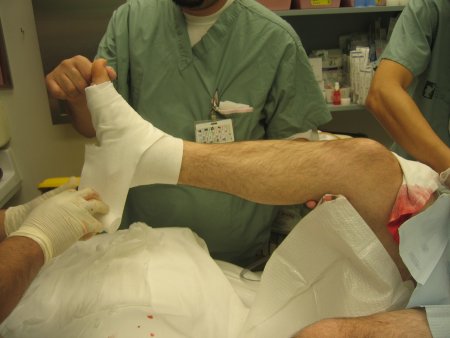 [Figure caption and citation for the preceding image starts]: Backslab application: the plaster slabs are then applied (2 side supports that wrap around the foot and one posterior support)From the collection of B. Petrisor, MD; used with permission [Citation ends].
[Figure caption and citation for the preceding image starts]: Backslab application: the plaster slabs are then applied (2 side supports that wrap around the foot and one posterior support)From the collection of B. Petrisor, MD; used with permission [Citation ends].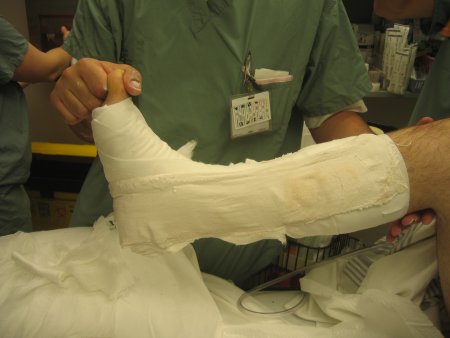 [Figure caption and citation for the preceding image starts]: Backslab application: an optional layer of Webril over the plaster prevents the tensor bandage or flannel from sticking and allows for ease of removal. The tensor bandage is then applied (some use flannel wrap) with minimal to no tension; it is "just rolled on"From the collection of B. Petrisor, MD; used with permission [Citation ends].
[Figure caption and citation for the preceding image starts]: Backslab application: an optional layer of Webril over the plaster prevents the tensor bandage or flannel from sticking and allows for ease of removal. The tensor bandage is then applied (some use flannel wrap) with minimal to no tension; it is "just rolled on"From the collection of B. Petrisor, MD; used with permission [Citation ends].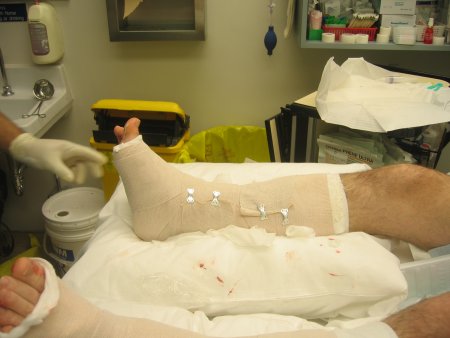
The AAOS suggests wound coverage for fewer than 7 days from injury date.[39]American Academy of Orthopedic Surgeons. Prevention of surgical site infections after major extremity trauma: evidence-based clinical practice guideline. Mar 2022 [internet publication].
https://www.aaos.org/globalassets/quality-and-practice-resources/dod/ssitrauma/ssitraumacpg.pdf
After closed fracture fixation, negative pressure wound therapy may mitigate the risk of revision surgery or the use of surgical site infection surveillance protocol. However, after open fracture fixation, negative pressure wound therapy does not appear to offer an advantage when compared with sealed dressings, as it does not decrease wound complications or amputations.[39]American Academy of Orthopedic Surgeons. Prevention of surgical site infections after major extremity trauma: evidence-based clinical practice guideline. Mar 2022 [internet publication].
https://www.aaos.org/globalassets/quality-and-practice-resources/dod/ssitrauma/ssitraumacpg.pdf
Silver-coated dressings are not suggested to improve outcomes or decrease pin site infections.[39]American Academy of Orthopedic Surgeons. Prevention of surgical site infections after major extremity trauma: evidence-based clinical practice guideline. Mar 2022 [internet publication].
https://www.aaos.org/globalassets/quality-and-practice-resources/dod/ssitrauma/ssitraumacpg.pdf
[40]American Academy of Orthopaedic Surgeons. Appropriate Use Criteria: prevention of surgical site infection after high energy extremity trauma. Mar 2022 [internet publication].
https://www.orthoguidelines.org/go/auc/auc.cfm?auc_id=225052
Isolated lateral malleolar fracture
If the fracture is nondisplaced, or very minimally displaced with congruent mortise and no talar shift visible on stress radiography, then a short-leg cast can be given for 6 weeks, with weight-bearing in the cast for the last 3 weeks. In one randomized, multicentre, noninferiority clinical trial, a shorter 3 week period of immobilization, either by cast or a simple orthosis, proved noninferior to traditional 6 weeks of cast immobilization for patients with stable, isolated Weber B type (transsyndesmotic) fibula fractures in their population, with a mean age of 45 years.[53]Kortekangas T, Haapasalo H, Flinkkilä T, et al. Three week versus six week immobilisation for stable Weber B type ankle fractures: randomised, multicentre, non-inferiority clinical trial. BMJ. 2019 Jan 23;364:k5432.
https://www.ncbi.nlm.nih.gov/pmc/articles/PMC6342249
http://www.ncbi.nlm.nih.gov/pubmed/30674451?tool=bestpractice.com
If there is talar shift, most patients will have open reduction and internal fixation; however, a short-leg nonweight-bearing cast for 6 weeks is still an option.
If the fracture is displaced and reducible, the options are either a short-leg nonweight-bearing cast for 6 weeks, or open reduction and internal fixation.[54]AO Surgery Reference. Infrasyndesmotic, medial fracture with lateral fracture/avulsion. 2024 [internet publication].
https://surgeryreference.aofoundation.org/orthopedic-trauma/adult-trauma/malleoli/infrasyndesmotic-medial-fracture-with-lateral-fracture-avulsion
If the talar shift and lateral malleolus are not reducible, the only option is open reduction and internal fixation.[55]Larsen P, Rathleff MS, Elsoe R. Surgical versus conservative treatment for ankle fractures in adults - a systematic review and meta-analysis of the benefits and harms. Foot Ankle Surg. 2019 Aug;25(4):409-17.
http://www.ncbi.nlm.nih.gov/pubmed/30321968?tool=bestpractice.com
One Cochrane review has shown that early treatment failure in nonoperatively treated patients led to surgery.[55]Larsen P, Rathleff MS, Elsoe R. Surgical versus conservative treatment for ankle fractures in adults - a systematic review and meta-analysis of the benefits and harms. Foot Ankle Surg. 2019 Aug;25(4):409-17.
http://www.ncbi.nlm.nih.gov/pubmed/30321968?tool=bestpractice.com
Noncomminuted lateral malleolar fractures may be fixed with: 1) an interfragmentary lag screw and a neutralization plate; 2) posterior antiglide plate; 3) fibular intramedullary device.[19]Kyriacou H, Mostafa AMHAM, Davies BM, et al. Principles and guidelines in the management of ankle fractures in adults. J Perioper Pract. 2021 Nov;31(11):427-34.
https://journals.sagepub.com/doi/full/10.1177/1750458920969029
http://www.ncbi.nlm.nih.gov/pubmed/33826430?tool=bestpractice.com
If the lateral malleolar fracture is comminuted, a bridge plate technique or intramedullary fixation may be used.[35]Lampridis V, Gougoulias N, Sakellariou A. Stability in ankle fractures: Diagnosis and treatment. EFORT Open Rev. 2018 May;3(5):294-303.
https://www.ncbi.nlm.nih.gov/pmc/articles/PMC5994620
http://www.ncbi.nlm.nih.gov/pubmed/29951269?tool=bestpractice.com
[56]Jain S, Haughton BA, Brew C. Intramedullary fixation of distal fibular fractures: a systematic review of clinical and functional outcomes. J Orthop Traumatol. 2014 Dec;15(4):245-54.
https://link.springer.com/article/10.1007/s10195-014-0320-0
http://www.ncbi.nlm.nih.gov/pubmed/25304004?tool=bestpractice.com
Cost-utility analysis has shown that surgical treatment is not cost-effective compared with nonoperative treatment after 1 year. However, on a lifetime time horizon, assumed for a >3% reduction in lifetime incidence of ankle osteoarthritis with open reduction and internal fixation (ORIF), surgical treatment was found to be cost-effective.[57]Slobogean GP, Marra CA, Sadatsafavi M, et al; Canadian Orthopedic Trauma Society. Is surgical fixation for stress-positive unstable ankle fractures cost effective? Results of a multicenter randomized control trial. J Orthop Trauma. 2012;26:652-658.
http://www.ncbi.nlm.nih.gov/pubmed/22473067?tool=bestpractice.com
Isolated medial malleolar fracture
If the fracture is nondisplaced or very minimally displaced, then a short-leg cast can be given for 6 weeks. If the fracture is displaced, then operative management is indicated.
For medial malleolar fractures a buttress plate may be used for shearing fractures.[19]Kyriacou H, Mostafa AMHAM, Davies BM, et al. Principles and guidelines in the management of ankle fractures in adults. J Perioper Pract. 2021 Nov;31(11):427-34.
https://journals.sagepub.com/doi/full/10.1177/1750458920969029
http://www.ncbi.nlm.nih.gov/pubmed/33826430?tool=bestpractice.com
Transverse medial malleolar fractures may be fixed with 1 or 2 cancellous lag screws, tension band technique, or Kirschner wire fixation.[58]Ebraheim NA, Ludwig T, Weston JT, et al. Comparison of surgical techniques of 111 medial malleolar fractures classified by fracture geometry. Foot Ankle Int. 2014 May;35(5):471-7.
http://www.ncbi.nlm.nih.gov/pubmed/24525543?tool=bestpractice.com
Bimalleolar/trimalleolar fractures
If the fracture is completely nondisplaced with a congruent ankle mortise, the options are for either a short-leg nonweight-bearing cast for 6 weeks, or open reduction and internal fixation.
If the fracture is displaced, the only option is open reduction and internal fixation.[43]Mordecai S, Al-Hadithy N. Management of ankle fractures. BMJ. 2011 Oct 28;343:d5204.
Bimalleolar ankle fractures or fractures where there is talar shift or syndesmotic injury should be referred for specialist orthopedic care.
If the fracture of the medial malleolus is minimally displaced after operative fixation of the fibula, nonoperative treatment yields similar results compared with operative treatment in terms of pain, development of osteoarthritis, and patient-reported functional outcome after a mean of 39 months.[59]Hoelsbrekken SE, Kaul-Jensen K, Mørch T, et al. Nonoperative treatment of the medial malleolus in bimalleolar and trimalleolar ankle fractures: a randomized controlled trial. J Orthop Trauma. 2013;27:633-637.
http://www.ncbi.nlm.nih.gov/pubmed/23454858?tool=bestpractice.com
Internal fixation
Operative fixation techniques for ankle fractures are varied. There are no guidelines for fixation devices.
Noncomminuted lateral malleolar fractures may be fixed with: 1) an interfragmentary lag screw and a neutralization plate; 2) posterior antiglide plate; 3) fibular intramedullary device.
If the lateral malleolar fracture is comminuted, a bridge plate technique may be used.
For medial malleolar fractures a buttress plate may be used for shearing fractures. Transverse medial malleolar fractures may be fixed with 1 or 2 cancellous lag screws, tension band technique, or Kirschner wire fixation.
After fixation of malleolar fractures, the syndesmosis should be tested for stability and, if unstable, fixation of the posterior malleolus or an anatomic reduction and stable fixation with syndesmotic screws are recommended.[35]Lampridis V, Gougoulias N, Sakellariou A. Stability in ankle fractures: Diagnosis and treatment. EFORT Open Rev. 2018 May;3(5):294-303.
https://www.ncbi.nlm.nih.gov/pmc/articles/PMC5994620
http://www.ncbi.nlm.nih.gov/pubmed/29951269?tool=bestpractice.com
Fractures of the posterior malleolus are associated with higher-energy injuries and worse clinical outcomes.[34]Stringfellow TD, Walters ST, Nash W, et al. Management of posterior malleolus fractures: a multicentre cohort study in the United Kingdom. Foot Ankle Surg. 2021 Aug;27(6):629-35.
http://www.ncbi.nlm.nih.gov/pubmed/32878722?tool=bestpractice.com
[60]Tansey PJ, Chen J, Panchbhavi VK. Current concepts in ankle fractures. J Clin Orthop Trauma. 2023 Oct 16;45:102260.
http://www.ncbi.nlm.nih.gov/pubmed/37872976?tool=bestpractice.com
[61]De Vries JS, Wijgman AJ, Sierevelt IN, et al. Long-term results of ankle fractures with a posterior malleolar fragment. J Foot Ankle Surg. 2005 May-Jun;44(3):211-7.
http://www.ncbi.nlm.nih.gov/pubmed/15940600?tool=bestpractice.com
[62]Tejwani NC, Pahk B, Egol KA. Effect of posterior malleolus fracture on outcome after unstable ankle fracture. J Trauma. 2010 Sep;69(3):666-9.
http://www.ncbi.nlm.nih.gov/pubmed/20838137?tool=bestpractice.com
[63]Odak S, Ahluwalia R, Unnikrishnan P, et al. Management of posterior malleolar fractures: a systematic review. J Foot Ankle Surg. 2016 Jan-Feb;55(1):140-5.
http://www.ncbi.nlm.nih.gov/pubmed/26100091?tool=bestpractice.com
Posterior malleolar fractures may be fixed with a posteriorly applied buttress plate or compression screws.[60]Tansey PJ, Chen J, Panchbhavi VK. Current concepts in ankle fractures. J Clin Orthop Trauma. 2023 Oct 16;45:102260.
http://www.ncbi.nlm.nih.gov/pubmed/37872976?tool=bestpractice.com
The decision to treat posterior malleolar fractures and the indications for treatment are controversial.[34]Stringfellow TD, Walters ST, Nash W, et al. Management of posterior malleolus fractures: a multicentre cohort study in the United Kingdom. Foot Ankle Surg. 2021 Aug;27(6):629-35.
http://www.ncbi.nlm.nih.gov/pubmed/32878722?tool=bestpractice.com
[60]Tansey PJ, Chen J, Panchbhavi VK. Current concepts in ankle fractures. J Clin Orthop Trauma. 2023 Oct 16;45:102260.
http://www.ncbi.nlm.nih.gov/pubmed/37872976?tool=bestpractice.com
Classic teaching suggests that fixation of the posterior malleolus be considered when the fracture size is greater than 25% to 33% of the joint surface.[61]De Vries JS, Wijgman AJ, Sierevelt IN, et al. Long-term results of ankle fractures with a posterior malleolar fragment. J Foot Ankle Surg. 2005 May-Jun;44(3):211-7.
http://www.ncbi.nlm.nih.gov/pubmed/15940600?tool=bestpractice.com
However, one meta-analysis suggests that this is based on low-quality evidence and that there is no consensus in the literature regarding the appropriate fracture size for fixation. The authors reported fixation of the medial and lateral malleoli is more important for overall stability.[64]van den Bekerom MP, Haverkamp D, Kloen P. Biomechanical and clinical evaluation of posterior malleolar fractures. A systematic review of the literature. J Trauma. 2009;66:279-84.
http://www.ncbi.nlm.nih.gov/pubmed/19131839?tool=bestpractice.com
There has been a move towards fixation of more posterior malleolar fractures, as even with small areas of the articular surface, there can be significant disruption to the posterior components of the syndesmosis.[60]Tansey PJ, Chen J, Panchbhavi VK. Current concepts in ankle fractures. J Clin Orthop Trauma. 2023 Oct 16;45:102260.
http://www.ncbi.nlm.nih.gov/pubmed/37872976?tool=bestpractice.com
[63]Odak S, Ahluwalia R, Unnikrishnan P, et al. Management of posterior malleolar fractures: a systematic review. J Foot Ankle Surg. 2016 Jan-Feb;55(1):140-5.
http://www.ncbi.nlm.nih.gov/pubmed/26100091?tool=bestpractice.com
The decision to treat posterior malleolar fractures may also be determined by other factors such as fracture displacement, congruency of the articular surface, and residual tibiotalar subluxation.[63]Odak S, Ahluwalia R, Unnikrishnan P, et al. Management of posterior malleolar fractures: a systematic review. J Foot Ankle Surg. 2016 Jan-Feb;55(1):140-5.
http://www.ncbi.nlm.nih.gov/pubmed/26100091?tool=bestpractice.com
Computed tomographic (CT) imaging may be helpful in defining fracture comminution, size and configuration where fracture of the posterior malleolus is known or suspected.[7]British Orthopaedic Association Standards for Trauma. The management of ankle fractures. Aug 2016 [internet publication].
https://www.boa.ac.uk/static/f8b1c499-c38a-4805-8cb8d8eb3087bca7/8be763eb-5921-4cb2-b6802f3e65ce8e7f/the%20management%20of%20ankle%20fractures.pdf
[33]Solan MC, Sakellariou A. Posterior malleolus fractures: worth fixing. Bone Joint J. 2017 Nov;99-B(11):1413-9.
http://www.ncbi.nlm.nih.gov/pubmed/29092978?tool=bestpractice.com
[34]Stringfellow TD, Walters ST, Nash W, et al. Management of posterior malleolus fractures: a multicentre cohort study in the United Kingdom. Foot Ankle Surg. 2021 Aug;27(6):629-35.
http://www.ncbi.nlm.nih.gov/pubmed/32878722?tool=bestpractice.com
[Figure caption and citation for the preceding image starts]: Mortise view of a trimalleolar fracture dislocation with concomitant disruption of the syndesmosisFrom the collection of B. Petrisor, MD; used with permission [Citation ends].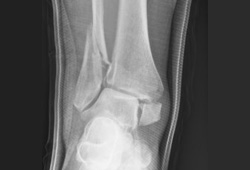 [Figure caption and citation for the preceding image starts]: Mortise view of a trimalleolar fracture after fixation. Note: 2 syndesmosis screws were also usedFrom the collection of B. Petrisor, MD; used with permission [Citation ends].
[Figure caption and citation for the preceding image starts]: Mortise view of a trimalleolar fracture after fixation. Note: 2 syndesmosis screws were also usedFrom the collection of B. Petrisor, MD; used with permission [Citation ends].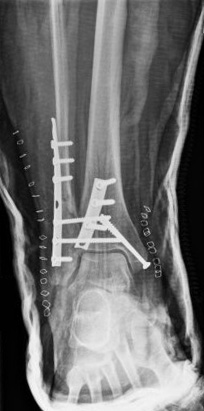 [Figure caption and citation for the preceding image starts]: Lateral view of a trimalleolar fracture after fixationFrom the collection of B. Petrisor, MD; used with permission [Citation ends].
[Figure caption and citation for the preceding image starts]: Lateral view of a trimalleolar fracture after fixationFrom the collection of B. Petrisor, MD; used with permission [Citation ends].
 [Figure caption and citation for the preceding image starts]: Backslab application: the plaster slabs are then applied (2 side supports that wrap around the foot and one posterior support)From the collection of B. Petrisor, MD; used with permission [Citation ends].
[Figure caption and citation for the preceding image starts]: Backslab application: the plaster slabs are then applied (2 side supports that wrap around the foot and one posterior support)From the collection of B. Petrisor, MD; used with permission [Citation ends]. [Figure caption and citation for the preceding image starts]: Backslab application: an optional layer of Webril over the plaster prevents the tensor bandage or flannel from sticking and allows for ease of removal. The tensor bandage is then applied (some use flannel wrap) with minimal to no tension; it is "just rolled on"From the collection of B. Petrisor, MD; used with permission [Citation ends].
[Figure caption and citation for the preceding image starts]: Backslab application: an optional layer of Webril over the plaster prevents the tensor bandage or flannel from sticking and allows for ease of removal. The tensor bandage is then applied (some use flannel wrap) with minimal to no tension; it is "just rolled on"From the collection of B. Petrisor, MD; used with permission [Citation ends].
 [Figure caption and citation for the preceding image starts]: Mortise view of a trimalleolar fracture after fixation. Note: 2 syndesmosis screws were also usedFrom the collection of B. Petrisor, MD; used with permission [Citation ends].
[Figure caption and citation for the preceding image starts]: Mortise view of a trimalleolar fracture after fixation. Note: 2 syndesmosis screws were also usedFrom the collection of B. Petrisor, MD; used with permission [Citation ends]. [Figure caption and citation for the preceding image starts]: Lateral view of a trimalleolar fracture after fixationFrom the collection of B. Petrisor, MD; used with permission [Citation ends].
[Figure caption and citation for the preceding image starts]: Lateral view of a trimalleolar fracture after fixationFrom the collection of B. Petrisor, MD; used with permission [Citation ends].